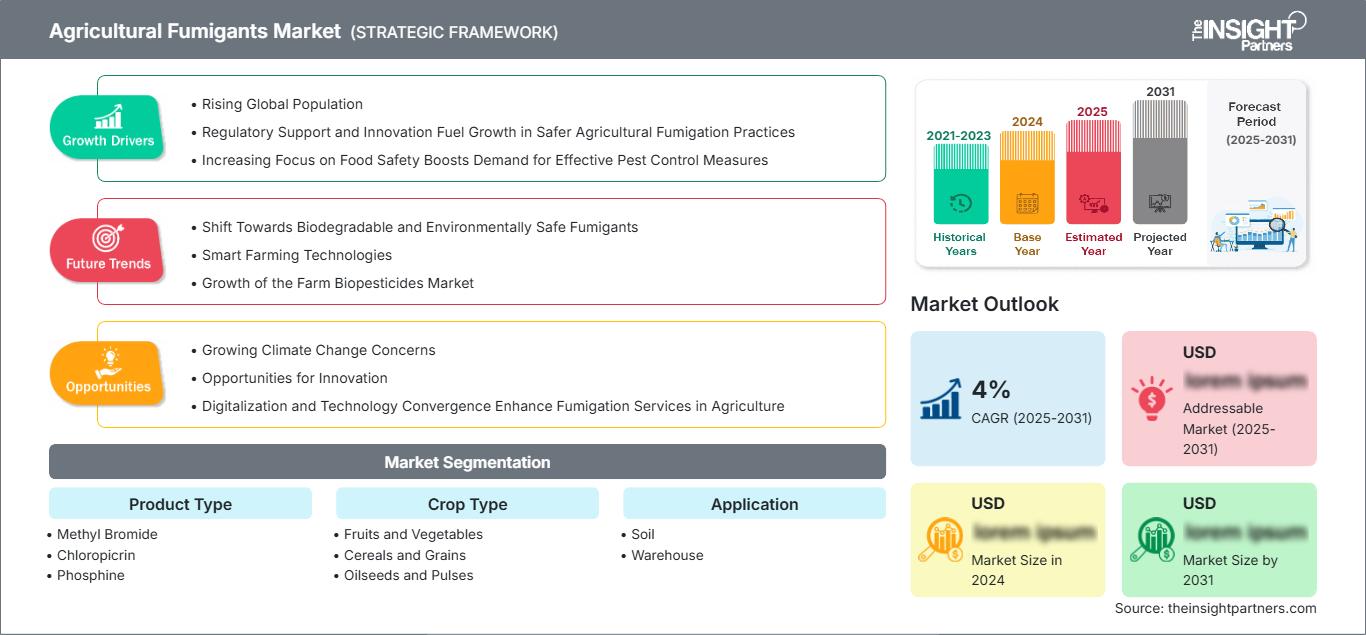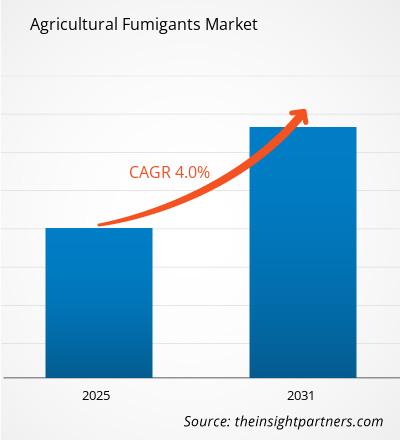The Agricultural Fumigants Market is expected to register a CAGR of 4% from 2025 to 2031, with a market size expanding from US$ XX million in 2024 to US$ XX Million by 2031.
The agricultural fumigants market report is segmented by product type (methyl bromide, chloropicrin, phosphine, metam sodium, 1 3-dichloropropene, and others). The market is segmented based on the crop type (fruits and vegetables, cereals and grains, oilseeds and pulses, and others). The market is segmented based on application (soil, warehouse, and others). The global analysis is further broken down at the regional level and major countries. The market size and forecast at global, regional, and country levels for all the key market segments are covered under the scope. The report offers the value in USD for the above analysis, segments, regions, and countries. The report covers market trends, as well as market dynamics such as drivers, restraints, and key opportunities. The report also covers industry landscape and competition analysis covering market concentration, heat map analysis, prominent players, and recent developments in the market.
Purpose of the Report
The report Agricultural Fumigants Market by The Insight Partners aims to describe the present landscape and future growth, top driving factors, challenges, and opportunities. This will provide insights to various business stakeholders, such as:
- Technology Providers/Manufacturers: To understand the evolving market dynamics and know the potential growth opportunities, enabling them to make informed strategic decisions.
- Investors: To conduct a comprehensive trend analysis regarding the market growth rate, market financial projections, and opportunities that exist across the value chain.
- Regulatory bodies: To regulate policies and police activities in the market with the aim of minimizing abuse, preserving investor trust and confidence, and upholding the integrity and stability of the market.
Agricultural Fumigants Market Segmentation
Product Type
- Methyl Bromide
- Chloropicrin
- Phosphine
- Metam Sodium
- 1 3-Dichloropropene
Crop Type
- Fruits and Vegetables
- Cereals and Grains
- Oilseeds and Pulses
Application
- Soil
- Warehouse
Geography
- North America
- Europe
- Asia-Pacific
- South and Central America
- Middle East and Africa
You will get customization on any report - free of charge - including parts of this report, or country-level analysis, Excel Data pack, as well as avail great offers and discounts for start-ups & universities
Agricultural Fumigants Market: Strategic Insights

-
Get Top Key Market Trends of this report.This FREE sample will include data analysis, ranging from market trends to estimates and forecasts.
Agricultural Fumigants Market Growth Drivers
- Rising Global Population: The increasing global population demands higher agricultural production. To address this, farmers have also turned to toxins that eliminate the pest and disease which would otherwise reduce the crops’ yield. Increased productivity through better pest management techniques unarguably is the major reason for the market.
- Regulatory Support and Innovation Fuel Growth in Safer Agricultural Fumigation Practices: Pest control is becoming a priority concern in the food security strategy of most countries. Hence, they have started to enact laws that encourage the use of agricultural fumigants without danger. Newer and better ways of carrying out fumigation, for example, devices that have less harmful effects on the surrounding ooze, support the growth of this market.
- Increasing Focus on Food Safety Boosts Demand for Effective Pest Control Measures: There is increasing concern regarding the quality and safety of food products. As a result, effective pest control measures are highly sought after in the market. Fumigants help to keep stored grains and crops pest-free, thereby promoting food safety.
Agricultural Fumigants Market Future Trends
- Shift Towards Biodegradable and Environmentally Safe Fumigants: The industry is certainly on a path to adopting sustainable practices in all operations. It is most likely that in the future development and use of fumigants will be biodegradable, less toxic safe for the environment. These changes have been experienced as a result of the government regulation on the use of agricultural fumigants and the ever-increasing trend for environmental issues from agriculture by society.
- Smart Farming Technologies: The innovative starring technologies of smart farming will also contribute to the handling of fumigation in the future. The use of data analytics, GPS, and IOT will enable farmers to apply fumigants more efficiently by pin-pointing stock pest infestations. This blowout manner of dealing with pests will yield a more economically appropriate and reasonable integrated pest management system.
- Growth of the Farm Biopesticides Market: With the growing health and environmental concerns of the population, it is estimated that the farm biopesticides market will expand. Healthier alternatives to chemical pesticides, these volatile organic compound-based fumigants are highly effective for pest control while ensuring decreased environmental and health risks, suggesting probable restructure in the fumigant market systems.
Agricultural Fumigants Market Opportunities
- Growing Climate Change Concerns: Advanced economies, especially in particular continents like Asia and Africa, offer immense possibilities. With growing climate change concerns, as these regions advance their agriculture methods and develop methods to control pests, there will be a high need for efficient fumigants which presents a good business opportunity for the manufacturers.
- Opportunities for Innovation: There exists great potential for improvement in the formulation and usage of fumigants. There are also benefits to be gained from investing in developing safe and effective new fumigant products, as it will create an upper hand against competitors. Joint efforts of these may lead to new developments in fumigant technologies.
- Digitalization and Technology Convergence Enhance Fumigation Services in Agriculture: The current process of digitalization of the agriculture business circular provides a good opportunity for embedding fumigation services into a digital platform. Companies can now use data and mobile applications to improve the efficiency and effectiveness of fumigation services in a customized way. This is referred to as technology convergence where new businesses are created and customers integrated in a better way.
Agricultural Fumigants Market Regional Insights
The regional trends and factors influencing the Agricultural Fumigants Market throughout the forecast period have been thoroughly explained by the analysts at The Insight Partners. This section also discusses Agricultural Fumigants Market segments and geography across North America, Europe, Asia Pacific, Middle East and Africa, and South and Central America.
Agricultural Fumigants Market Report Scope
| Report Attribute | Details |
|---|---|
| Market size in 2024 | US$ XX million |
| Market Size by 2031 | US$ XX Million |
| Global CAGR (2025 - 2031) | 4% |
| Historical Data | 2021-2023 |
| Forecast period | 2025-2031 |
| Segments Covered |
By Product Type
|
| Regions and Countries Covered |
North America
|
| Market leaders and key company profiles |
|
Agricultural Fumigants Market Players Density: Understanding Its Impact on Business Dynamics
The Agricultural Fumigants Market is growing rapidly, driven by increasing end-user demand due to factors such as evolving consumer preferences, technological advancements, and greater awareness of the product's benefits. As demand rises, businesses are expanding their offerings, innovating to meet consumer needs, and capitalizing on emerging trends, which further fuels market growth.

- Get the Agricultural Fumigants Market top key players overview
Key Selling Points
- Comprehensive Coverage: The report comprehensively covers the analysis of products, services, types, and end users of the Agricultural Fumigants Market, providing a holistic landscape.
- Expert Analysis: The report is compiled based on the in-depth understanding of industry experts and analysts.
- Up-to-date Information: The report assures business relevance due to its coverage of recent information and data trends.
- Customization Options: This report can be customized to cater to specific client requirements and suit the business strategies aptly.
The research report on the Agricultural Fumigants Market can, therefore, help spearhead the trail of decoding and understanding the industry scenario and growth prospects. Although there can be a few valid concerns, the overall benefits of this report tend to outweigh the disadvantages.
Frequently Asked Questions
What is the future trend for agricultural fumigants market?
Based on geography, which region held the largest share of the agricultural fumigants market?
Which is the fastest growing segment based on crop type?
What are the key players operating in the agricultural fumigants market?
What are the driving factors impacting the agricultural fumigants market ?
What is the expected CAGR of the Agricultural Fumigants Market?
- Historical Analysis (2 Years), Base Year, Forecast (7 Years) with CAGR
- PEST and SWOT Analysis
- Market Size Value / Volume - Global, Regional, Country
- Industry and Competitive Landscape
- Excel Dataset
Recent Reports
Testimonials
Reason to Buy
- Informed Decision-Making
- Understanding Market Dynamics
- Competitive Analysis
- Identifying Emerging Markets
- Customer Insights
- Market Forecasts
- Risk Mitigation
- Boosting Operational Efficiency
- Strategic Planning
- Investment Justification
- Tracking Industry Innovations
- Aligning with Regulatory Trends





















 Get Free Sample For
Get Free Sample For